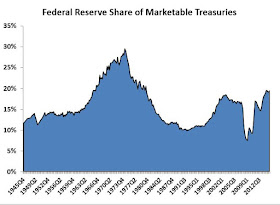As a follow up to my last post, I want to repeat a point I have made before. Not only is the Fed not responsible for the low interest rates during the past seven years, but it is also not responsible for enabling the large budget deficits that occurred during this time.1
But how can this be? Was not the Fed involved in massive asset purchase programs of government debt? For some it is obvious that through these programs the Fed was the 'great enabler' of the run up in government debt since 2008. Here, for example, are two former Fed officials making this claim a few years ago at a conference:
Mr Warsh and Mr Poole (who was filling in for Allan Meltzer) made a sharp distinction between the “legitimate” efforts to fight the crisis and the subsequent easing actions that were, allegedly, unjustified by the economic fundamentals. According to them, the interventions of 2007-2009 were required to ensure that “the markets could clear”, as Mr Warsh put it, while the second round of easing was done to satisfy “political masters” by monetising the debt. In fact, Mr Warsh said that the Fed was being actively unhelpful by “crowding in” Congress’s supposedly poor policy choices.
Yes, the Fed did engage in several rounds of 'quantitative easing' (QE) where it bought up a large number of treasury and agency securities. The amounts, however, were not that large relative to the total amount of securities outstanding. The Fed, therefore really was not much more than a bit player in the market for these securities.
To see this, take a look at the absolute dollar amount of the Fed's treasury and agency assets relative to total for 2015:Q2. Of the approximately $12.67 trillion in marketable treasuries, the Fed owned $2.46 trillion. Similarly, of the roughly $8.71 trillion in mortgage-related securities the Fed ownsed $1.72 trillion. In both cases that amounts to about 19% of the total. That is not quite the image of a 'great enabler' now is it?
This point is even more clear in the figure below. It shows the most of the run up in marketable public debt since 2008 was not due to the Fed. The black sliver in the figure represents the Fed's share of the total.
If we take the data from the figure above and put the Fed's share a percent of the total we get the following figure. Note that the Fed's current 19% is not that different from where it was in the decade prior to the crisis. Yet, we did not hear people making the 'great enabler' claims back then.
If we zoom in on this figure we see something rather remarkable. There was a sharp reduction in the Fed's share of marketable treasuries in 2007-2008. The Fed critics, however, only seem to notice the QE periods. Where were they during the 2007-2008 period? They fail to see that the QE programs effectively reversed the 2007-2008 reduction of treasury holdings by the Fed, which itself was not all that much in the grand scheme of things.
Finally, let me conclude with the following figure. It shows 10-year yields on government bonds for the United States, Germany, United Kingdom, and Japan--all countries whose treasury securities are considered safe assets. Note that all of them see their yields start to drop in mid-2008 as the panic kicks and they have yet to return. Moreover, they all fell in a similar fashion. Surely, this has to be more than just the Fed at work. It has to do with a surge in risk-aversion that has yet to fully return to normal levels.
So who is ultimately responsible for the low interest rates? Like I said in my last post, market forces are responsible for the low interest rates. And who is the market? You, me, our financial intermediaries, and foreigners. If you want to blame anyone for low interest rates start by looking in the mirror.
Update: Using SIFMA statistics, I constructed a pie chart to show who the current holders of treasury debt are as of 2015:Q2. Using this data, the Fed holdings come out a bit less than the 19% calculated above using the financial accounts data. Also, financial intermediaries include mutual funds, banking institutions, insurance companies, and pension funds.
1Okay, if pressed I would say the Fed actually is indirectly responsible for the low rates for allowing the crisis to emerge and then not doing enough to end it promptly. This, though, is a very different argument than the one that says the Fed directly caused the low interest rates.
Update: Using SIFMA statistics, I constructed a pie chart to show who the current holders of treasury debt are as of 2015:Q2. Using this data, the Fed holdings come out a bit less than the 19% calculated above using the financial accounts data. Also, financial intermediaries include mutual funds, banking institutions, insurance companies, and pension funds.
1Okay, if pressed I would say the Fed actually is indirectly responsible for the low rates for allowing the crisis to emerge and then not doing enough to end it promptly. This, though, is a very different argument than the one that says the Fed directly caused the low interest rates.















